The evolution of the farmers market
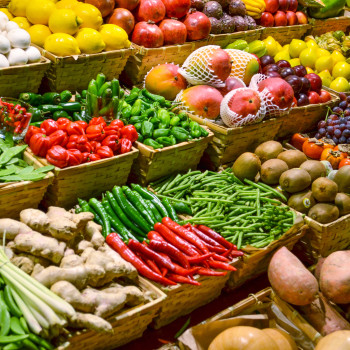
With two new indoor markets potentially on the cards in Dublin alone, Gillian Hamill examines the evolution of the humble farmers’ market and finds Cork’s famous English Market is not the only one keen to get the artisan and natural foodie scene covered
16 October 2014
We’re at a very interesting point in Ireland, according to Ciaran Casey, joint director of Markets Alive Support Team (Mast.ie), on the topic of the development of markets in Ireland. “I see the market sector continuing to grow at the same rate and I would say it’s probably grown this year so far at 10%. The reason being that it’s a re-entry to business, minus the crippling overheads of a bricks and mortar business. In the last 18 months, at least a dozen of our members have made the transition from market trader to a bricks and mortar business….It’s providing people with a spring board and also you’re getting experience at running a business as well, you learn the nuts and bolts with a very low initial outlay which I think is very important.”
Plans in the capital
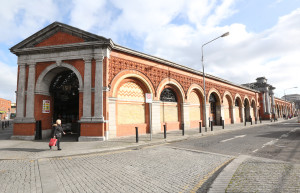 What’s more, Irish markets are becoming increasingly sophisticated, with greater numbers of indoor markets now appearing on the scene in response to our famously overcast weather. Within Dublin, plans are on the horizon for not one, but two indoor foodie havens. Dublin City Council has reportedly put aside €3m to develop a food market similar to London’s Covent Garden, through redeveloping Dublin’s Victorian fruit and vegetable market. Located in north inner city Dublin, behind the Four Courts, it is hoped that construction will start as soon as next month and that the redevelopment will be finished by September next year. At present, the market is only used by wholesalers but the new plans would see half of the market converted into a space for artisan food producers and cafés. The new market would be run by a management company appointed by Dublin City Council and overseen by a special markets committee of councillors.
What’s more, Irish markets are becoming increasingly sophisticated, with greater numbers of indoor markets now appearing on the scene in response to our famously overcast weather. Within Dublin, plans are on the horizon for not one, but two indoor foodie havens. Dublin City Council has reportedly put aside €3m to develop a food market similar to London’s Covent Garden, through redeveloping Dublin’s Victorian fruit and vegetable market. Located in north inner city Dublin, behind the Four Courts, it is hoped that construction will start as soon as next month and that the redevelopment will be finished by September next year. At present, the market is only used by wholesalers but the new plans would see half of the market converted into a space for artisan food producers and cafés. The new market would be run by a management company appointed by Dublin City Council and overseen by a special markets committee of councillors.
Iveagh Markets regeneration on the cards
The Victorian fruit and vegetable market is not the only plan for a Covent Garden style development in the capital though. Martin Keane, who owns Blooms Hotel and the Oliver St John Gogarty pub and hostel in Temple Bar, also owns the Iveagh Markets in Dublin’s Liberties. Keane appears determined not to have this historic landmark consigned to the dustbin of history. According to an Irish Times report, he has “extensive plans to modernise and reopen the markets and build an adjoining glass-fronted hotel with an entrance on to Lamb Alley”. Keane said of his plans, which also involve an underground craft distillery and brewery: “The idea is to do an Irish version of Covent Garden with farmers’ markets, art and craft sections, and retailers selling Irish tweeds and clothing.” Describing the project as his “lifetime dream”, the owner was keen to highlight the fact that the properties are not in Nama and are debt-free. He said he would employ 350 – 400 during the construction phase and between 450 – 500 people when the market is open, including self-employed crafts people.
The first step will be to underpin the entire building before construction can begin. Keane intends the market to be open seven days a week, with food tastings and performances also on the menu. Talking numbers, Keane divulged that he bought the Iveagh Markets and Mother Redcap’s pub and markets beside it on Francis Street for a total of €14 million. He has spent €9.5 million so far and will need to spend €78 million more. This will come from personal funds and loans from financial institutions and he is also hoping to secure European funding for the project’s heritage element.
Covering all bases in Ennis
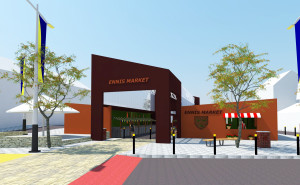 Another scheme involving significant numbers is the redevelopment of the farmers market in Ennis, Co. Clare where plans have been put forward to cover the market with a permanent glass roof. ShelfLife spoke to Ger Dollard, director of service at Clare County Council, who confirmed that the project was aiming for a loan approval of €1.75 million which would include design fees. He noted: “A lot of the cost is in what I’d call the public realm of improvement. It’s a covered market but also paving and the surrounding streetscape needs to be improved. So the total cost is probably €1.5 million for physical costs and half of a million of that is related to the actual physical structure of the covered market.”
Another scheme involving significant numbers is the redevelopment of the farmers market in Ennis, Co. Clare where plans have been put forward to cover the market with a permanent glass roof. ShelfLife spoke to Ger Dollard, director of service at Clare County Council, who confirmed that the project was aiming for a loan approval of €1.75 million which would include design fees. He noted: “A lot of the cost is in what I’d call the public realm of improvement. It’s a covered market but also paving and the surrounding streetscape needs to be improved. So the total cost is probably €1.5 million for physical costs and half of a million of that is related to the actual physical structure of the covered market.”
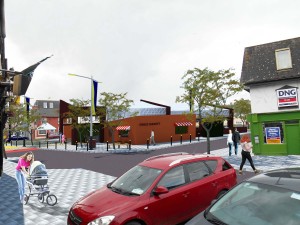 Explaining why he feels now is the right time for such a development to proceed, he says: “Firstly we were involved in a high court case regarding our casual trading by-laws and until that process was completed there was little point in trying to do anything with the market in Ennis. Secondly, I think over the years it’s been obvious to everybody that the public’s expectations of a market has changed and that the idea of covered markets has emerged in many other areas, in Limerick, Meeting House Square in Dublin and certainly on the international scene, they would be fairly common.”
Explaining why he feels now is the right time for such a development to proceed, he says: “Firstly we were involved in a high court case regarding our casual trading by-laws and until that process was completed there was little point in trying to do anything with the market in Ennis. Secondly, I think over the years it’s been obvious to everybody that the public’s expectations of a market has changed and that the idea of covered markets has emerged in many other areas, in Limerick, Meeting House Square in Dublin and certainly on the international scene, they would be fairly common.”
Rejuvenating an area
He believes the market is a real footfall generator that can help improve the entire town’s offering. “We see the market as central to Ennis and if we can revitalise and rejuvenate the market that will have a spin-off effect on the wider town centre area…One of the main steps in that would be to modernise it without losing the market culture and ethos.”
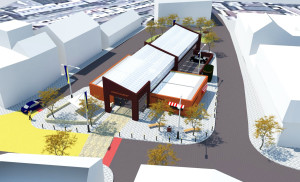 Mast.ie’s Ciaran Casey also believes that markets can bring new life to an area, working in conjunction with existing businesses. He concedes: “I have heard complaints, not so much from retailers, [but] from restaurant businesses and cafés, that the lunchtime markets are affecting their trade. Basically these lunchtime markets exist throughout the EU and the UK and they get along absolutely fine with the attendant house bound businesses. In that way, I think it’s down to the retail restaurant trade. If they’re getting affected, then I think they need to adapt.”
Mast.ie’s Ciaran Casey also believes that markets can bring new life to an area, working in conjunction with existing businesses. He concedes: “I have heard complaints, not so much from retailers, [but] from restaurant businesses and cafés, that the lunchtime markets are affecting their trade. Basically these lunchtime markets exist throughout the EU and the UK and they get along absolutely fine with the attendant house bound businesses. In that way, I think it’s down to the retail restaurant trade. If they’re getting affected, then I think they need to adapt.”
The social aspect of markets is another important factor according to Casey, who himself ran the Celtic Jewellery stall outside Trinity College from 1985 until 2002 and believes that “being in that informal setting, gives you a lot more freedom in your interaction with the customer.” Kathleen Smith, the owner of Longford Indoor Market which runs every Saturday, is firmly in agreement. “They’re a good venue for people. I find a lot of people just love to come and meet at them and have a chat, it’s a lovely, open space to do that.” She adds: “They’re good in that they’re helping to bring more people into the area. They do create a small bit of competition but what people do at markets is very different from what people do at shops. It helps alongside town businesses.”
Something that works for everyone
The proposals in Ennis appear to be making good progress. According to Dollard: “Our timeframe is we have been through the planning process, it’s been fully approved by the local authority. We are finalising the details of the design, we have an application in for loan funding with the department and if we get [that], I would expect we would be going to tender probably within the next month to two months and hopefully starting construction early in 2015.”
Some traders have expressed concern however that the market’s proposed improvements will increase their own costs and Dollard believes it’s important that the scheme “works for everyone” involved. “It’s like any significant change in that people’s reaction to it can be one of concern,” he says. “There have been some concerns raised by people who use the current market and there have been some concerns raised by residents adjoining the current market. We’ve done our best to alleviate those concerns and we have undertaken that when the final detailed design is done, we will sit down with those groups again and I suppose really what we all want is something that works and it needs to work for the traders, the residents and the wider community and I certainly think that we can achieve that.”
While the discounters are increasing in popularity moreover, Dollard believes there will always be a place for the type of quality produce available at farmers markets. “I think you’ll always have a demand for the type of organic, naturally grown produce that the farmers market will produce,” he says. To this end, he adds that they will be “trying to develop a brand around the new market”.
A Lidl controversy
Given that markets generally place a great deal of emphasis on where products have been sourced, controversy was recently created on Cork’s 96FM Opinion Line programme. The show investigated and confirmed reports that one of the traders at Cork’s English Market, Michael Herlihy of The Farmer stall, was buying some of his vegetables at a Lidl in Cork and selling it at a marked-up rate. The show’s producer Deirdre O’Shaughnessy outlined on air how she had visited the stall and found it was selling Lidl brand Oaklands spinach, kale and baby potatoes with labels saying “Packaged for Lidl”. Listeners subsequently reported seeing Lidl’s baby potatoes costing 49 cents, being sold at The Farmer stall for €1 per bag.
However, Michael Herlily, who has run The Farmer Stall for almost 30 years, and who never claimed the products in question were either local or organic, has defended his actions. According to the Irish Examiner, he said he has never attempted to hide the fact that the products mentioned had been bought in a supermarket. “I leave those products in their original packaging to ensure full traceability of the products — so people know where they came from,” said Herlihy. He added that he adopted the practice because some city-based restaurateurs want to buy particular products, such as baby potatoes of uniform size from his stall, which he said he cannot source from the four major wholesalers he deals with. It was later reported that Herlihy had not lost any business from his restaurant customers following the Opinion Line report.
Nevertheless, a spokesman for the market trader’s association said the practices revealed at this stall are “no reflection” on the other traders, stating: “Most traders source and select the local fresh food products they sell very, very carefully.” Fishmonger Pat O’Connell who was photographed joking with Queen Elizabeth during her visit to the market in 2011, also said many traders were frustrated by the episode. “It goes against the whole ethos of what this market is about – we take huge pride in being able to say this produce is fresh and it’s local but something like this goes against the culture of the market and what it should be about and what it is about for most traders,” he said.
Taking inspiration from abroad
 Undoubtedly reputation is very important if the markets scene is to continue to flourish and Casey believes having the right facilities available is also essential. He recently attended the World Union of Wholesalers conference in London which was previously held in Dublin in 2010. “I’ve been to Hamburg, Madrid, Rotterdam, the Hague, Amsterdam and Paris and the facilities available to the traders from the local authorities in all of these countries is just mind-boggling. We just do not have it.”
Undoubtedly reputation is very important if the markets scene is to continue to flourish and Casey believes having the right facilities available is also essential. He recently attended the World Union of Wholesalers conference in London which was previously held in Dublin in 2010. “I’ve been to Hamburg, Madrid, Rotterdam, the Hague, Amsterdam and Paris and the facilities available to the traders from the local authorities in all of these countries is just mind-boggling. We just do not have it.”
He believes the number one factor where Ireland loses out is the strong locations of markets in other countries. “Look at what they have, all the indoor markets in London, they’re either council owned or they were council properties and they’re now owned by co-ops; they’re providing trading spaces at very reasonable rates, at Convent Garden in London, you’ve also got Billingsgate, you’ve got Brixton Village Market which is absolutely astounding, it’s almost like an Arab souk with five arcades, radiating out from a central point and there’s all of these amazing shops and food vendors and restaurants and shops selling food that [the owners] can sell themselves. They’re all there and they’re there very happily together.” If recent proposals are anything to go by, Ireland is clearly taking inspiration from our UK and continental neighbours when it comes to marketing our markets as attractive shopping destinations.



 Print
Print



Fans 0
Followers